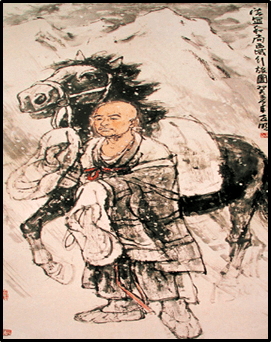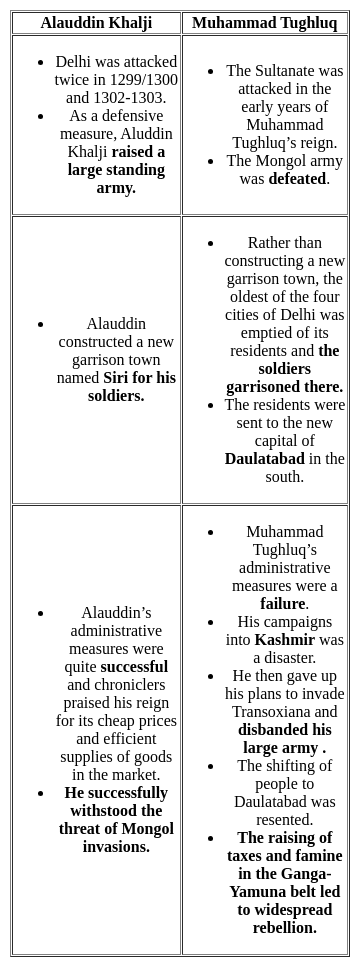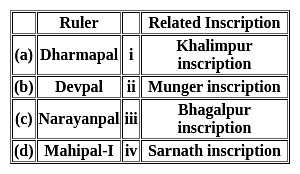MH SET Paper 2 Mock Test - 7 (History) - MAHA TET MCQ
30 Questions MCQ Test - MH SET Paper 2 Mock Test - 7 (History)
Consider the following statements:
1. Trearty of Purandar was signed between the Rajput ruler Jai Singh I and Shivaji Maharaj.
2. Jahandar Shah was the successor of Mughal empire after the death of Bahadur Shah.
3. Nadir Shah invaded India during the reign of Muhammad Shah.
Which of the above given statements is/are correct?
| 1 Crore+ students have signed up on EduRev. Have you? Download the App |
Bhagwati sutra is related to which of the following religions?
Consider the following statements related to King Anandpal:
(A) Anandpal was the son of King Jaipala.
(B) He fought against Mahmud Ghaznavi in the First battle of Waihind.
(C) He shifted his capital to Nandana after the defeat from Mahmud Ghaznavi.
Which of the above given statements are correct?
Consider the following statements regarding the Gupta age:
1. Law-abiding people.
2. Equality was well established in society.
3. Non-veg food was allowed.
Which of the above descriptions were not mentioned in Fa-Hien’s account?With reference to the Mahalwari System, consider the following statements.
I. It was introduced in the Ganga valley, the North-West Provices, parts of Central India, and the Punjab.
II. The revenue settlement was to be made village by village or estate (mahal) by estate.
III. In Punjab a modified Mahalwari system known as the village system was introduced.
Choose the incorrect statements.
In regard of token currency issued by Sultan Muhammad Tughlaq, which of the following statements are correct?
(A) According to Barani, the metal used for the token coins was copper
(B) Ferishta says it was brass or bronze
(C) While other coins had only Arabic super inscriptions, the token coin had its legends in Persian also
(D) No care was taken to make the legend on the token coins clear and legible
Choose the correct answer from the options give below:
With reference to Indian Medieval History, consider the following statements:
1. The Mongols appeared on the northwestern frontier of India for the first time during reign of Iltutmish under the leadership of Chengez Khan.
2. The raising of taxes and famine in the Ganga-Yamuna belt during Alauddin Khilji led to widespread rebellion.
3. Alauddin Khilji sent his toughest generals: Ghazi Malik and Malik Kafur to protect the country from Mongol invasion.
How many of the statements given above are correct?
With reference to the Permanent Settlement of 1793, consider the following statements.
1) The man who planned the system was John Shore, who succeeded Cornwallis as Governor-General.
2) The zamindars were not only to act as agents of the government in collecting land revenue but also to become the owners of the entire land in their zamindaris.
3) Their right of ownership was transferable but not hereditary.
Choose the correct statements.
Read statements A, B and C and select correct answer.
Why Magadha became the most important Mahajanpada in about two hundred years?
A. Many rivers such as Ganga and Son flowed through Magadha.
B. Parts of Magadha were forested.
C. There were iron ore mines in the region.
Who among the following was the most important divinity during the early Vedic era?
With reference to the Mughal architecture Pietra dura (inlaid mosaic work), consider the following statements:
- It was introduced for the first time under Shah Jahan.
- It was used in Itamad-ud-Daul’s tomb for the first time.
- It was also the basis for Taj Mahal.
Which of the statements given above is incorrect?
Postmodern critiques of historical representation often rely on the concept of:
Consider the following statements.
1. On 10 May 1857, the sepoys in the cantonment of Meerut broke out in mutiny.
2. Gonoo was a leader of the Singhbhum tribal region of the 1857 revolt.
3. Governor-General Lord William Bentinck described the kingdom of Awadh as “a cherry that will drop into our mouth one day”.
Select the correct answer by using the code given below.
Which one of the following is the unique festival of Bihar?
Choose the reason/reasons behind the commercialization of agriculture during British rule :
1. India was reduced to a supplier of raw materials.
2. Better means of transportation made trade-in agro products feasible.
3. Monetization of land revenue payment.
4. Industrial Revolution in England.
Choose the correct option :
Match List I with List II, and select the correct answer by using the codes given below the lists:
FORM OF MUSIC
1. Drupad
2. Khayal
3. Thumri
4. Tappa
THEME
a. Devotional in theme and content
b. Emotional account possibly from poetic observation
c. Conversation type songs, usually romantic
d. Folk songs of the camel riders
Codes:
Consider the following Maratha Powers with treaties which they had with British:
- Peshwa – Treaty of Bassein
- Bhonsle – Treaty of Deogaon
- Sindhia – Treaty of Surji Anjangaon
Which of the above is/are correct?
Which of the following statement is/are correct?
- Jahandar Shah II encouraged Jazia System.
- Nadir Shah of Persia invaded with the help of Sadat Khan who defeated the Mughal army at the Battle of Buxar.
- Marathas under Baji Rao, for the first in Mughal history, raided in Delhi.
Select the correct code from below.
In which year there was a mutiny by the sepoys at Vellore due to the replacement of the turban they wore, by a leather cockade.
Which of the following statements about Ellora caves is correct?
- They were initially built by Saatavahanas.
- These caves belong to 6th to 10th century A.D.
- Unlike Ajanta caves, these caves are dedicated to only one religion, i.e., Buddhism.
Select the correct answer using the codes given below:
King Charles II handed over the Bombay Island to the company in which year?
Consider the following statements about the Pandyan Kingdom:
1. The first time it was mentioned by Fa-Hien.
2. They used to earn profits by trading with the Roman empire.
Which of the above statements is/are correct?Consider the following statements with reference to Akbar’s reign.
1. In the first phase of Akbar’s reign, the Mughal empire was challenged by Afghan forces under Hemu.
2. Bairam Khan as regent of Akbar shared his power and influence with nobles of the court.
Which of the above statements is/are correct?Which of the following is / are correct statements about Sarojini Naidu?
She was first woman to become President of Indian National Congress
She was first woman to become the governor of an Indian state
She was awarded by British “Kaiser-i-Hind medal” for her contribution towards welfare of World War -I victims
Select the correct option from the codes given below:
Which of the following statement(s) about the India election of 1945 is/are correct?
1. Congress emerged as the largest party by capturing 52 of 109 seats in the Central Assembly.
2. Muslim league captured all the Muslim reserved seats in the Central Assembly.
3. In the provincial elections, the Muslim league got a majority in Bengal, Punjab, and Sindh.
Select the correct code from below:
Match the following list:

Choose the correct combination given below:
Consider the following statements:
1. The All India Kisan Sabha was founded by Gauri Shankar Mishra and Indra Narayan Dwivedi
2. The Congress Manifesto for the 1937 provincial elections was strongly influenced by the Awadh Kisan Sabha
3. All India Kisan Sabha is also known as ‘Akhil Bhartiya Kisan Sabha.’
Which of the above statements is/are correct?




















